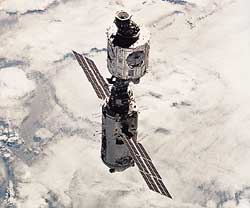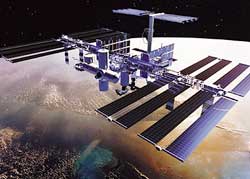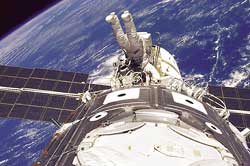World Book at NASA
 |
|
Two modules of the International Space Station were launched and assembled in 1998 by the United States and Russia. Image credit: NASA |
The International Space Station orbits Earth at an altitude of about 250 miles (400 kilometers). The orbit extends from 52 degrees north latitude to 52 degrees south latitude.
The station will include about eight large cylindrical sections called modules. Each module is being launched from Earth separately, and astronauts and cosmonauts are connecting the sections in space. Eight solar panels will supply more than 100 kilowatts of electric power to the station. The panels are being mounted on a metal framework 360 feet (109 meters) long.
 |
|
The International Space Station will function as an observatory, laboratory, and workshop. Astronauts and cosmonauts will live and work in cylindrical modules, and solar panels will furnish electric power. Fifteen countries are building the station, shown here as it will look when finished. Image credit: NASA |
More than 80 flights of U.S. space shuttles and Russian rockets will be necessary to complete the International Space Station. The ESA and Japan plan to develop supply vehicles to be launched on the ESA's Ariane 5 and Japan's H-2A booster rockets. The space station was originally scheduled for completion in 2006, but unpredicted expenses have created major delays.
Missions
The crew and scientists on Earth -- using radio signals -- operate laboratory equipment on the station. Some of the equipment measures the effects of space conditions, such as apparent weightlessness, on biological specimens -- including the crew. Other equipment produces various materials, including protein crystals for medical research. Crystals grown in space have fewer imperfections than those grown on Earth and are therefore easier to analyze. Medical researchers will use results of protein analyses to determine which crystals to mass-produce on Earth.
The major value of having a space station is that all the equipment needs to be carried into space only once. Also, the station can be used again and again by visiting astronauts and cosmonauts. Scientists on Earth can analyze experimental results and modify follow-up investigations much more quickly than before. The station has been designed to operate for at least 15 years. But it could last for decades if parts are repaired and replaced as they wear out or are damaged.
History
The International Space Station is the ninth inhabited space station to orbit Earth. The first such stations, consisting of six models of the Soviet Salyut station and the U.S. Skylab, were launched in the 1970's.
In 1986, the Soviet Union began operating Mir, the first space station to use a modular design. The Soviets developed a reliable, economical transportation system, based on Soyuz spacecraft, for the station. The system enabled them to deliver supplies, equipment, and crew members to Mir. Following the collapse of the Soviet Union in 1991, Russia took over the operation of Mir. Russian cosmonauts handled major breakdowns on the station, which was wearing out. In March 2001, Russia took Mir out of orbit and sent it plunging to Earth.
Russia had intended to construct a station known as Mir 2 in the 1990's. The United States had planned to build a station called Freedom in partnership with space agencies in Europe, Canada, and Japan. But due to funding difficulties, the United States and Russia agreed in 1993 to build a combined station -- the International Space Station.
To prepare for the project, shuttles flew to Mir from 1995 to 1998. United States astronauts served on board the Russian station as researchers for as long as six months.
Major delays occurred in the construction of the International Space Station due to cutbacks in funding by the Russian government. A Russian Proton rocket finally launched the first module in November 1998. The module was a Russian-built and United States-funded unit called Zarya or the FGB. Zarya means sunrise in Russian, and FGB stands for functional cargo block.
The second module, Unity, was built by the United States. The space shuttle Endeavour carried Unity into orbit in December 1998, and it was then joined to Zarya. Unity has six hatches. One is connected to Zarya, and others serve as connectors for other modules.
In July 2000, a Proton rocket launched the Russian-built Zvezda (Star), or Service Module. Zvezda has living and working quarters for astronauts and cosmonauts. In October 2000, the shuttle Discovery carried up several more pieces. Those included a support truss for solar panels and a connecting unit called a Pressurized Mating Adapter (PMA). The PMA provided a docking port for shuttles.
The first full-time crew, known as Expedition One, arrived in a Soyuz in November 2000. The crew commander was astronaut William Shepherd, and the other members were cosmonauts Yuri Gidzenko and Sergei Krikalev. Later that month, Endeavour carried the first four U.S.-built solar panels into space to supplement the small panels on the Russian modules.
 |
|
The first two modules of the International Space Station were assembled in December 1998. In the foreground is the Unity module, which was built by the United States. Behind Unity, with solar panels attached to it, is a Russian-built module named Zarya -- the Russian word for sunrise. Image credit: NASA |
In April 2001, the first space tourist traveled as a passenger in a Soyuz-replacement mission. Dennis Tito, an investment consultant from California, purchased the trip for an undisclosed price. He trained in Moscow for six months before the flight and spent six days aboard the station. South African businessman Mark Shuttleworth became the second space tourist when he purchased a ride on a Soyuz-replacement mission launched in April 2002. Other Soyuz missions carried astronauts selected and sponsored by the ESA.
The next stages of construction were to expand the station's power and life-support systems to support a full-time crew of six or seven. To provide emergency return capability for a crew that large, NASA planned to build a seven-person escape craft. But during 2001, it became clear that NASA had greatly underestimated the cost of developing and operating the station. NASA's cost for the station was about $5 billion over budget. As a result, NASA suspended the plan to enlarge the crew and build the escape craft. NASA's partners in Europe and Japan strongly objected to that decision.
In 2002, the station continued to operate with a crew of three. Space shuttles replaced the crew every four or five months. Russian cosmonauts also flew a new Soyuz spacecraft to the station every six months. The Soyuz would serve as a "bail-out capsule" in case of a life-threatening emergency. The expansion of the power system continued, but more slowly than originally planned.
On Feb. 1, 2003, the space shuttle Columbia broke apart on reentry into Earth's atmosphere, killing all seven crew members. NASA halted shuttle flights until it could ensure the safety of future flights. Soyuz missions then began carrying crews to and from the station. The station's crew was reduced to two people to conserve supplies normally carried to the station by shuttles.
Contributor:
James Oberg, M.S., Spaceflight Engineer; author, UFOs and Outer Space Mysteries.
How to cite this article:
To cite this article, World Book recommends the following format:
Oberg, James. "International Space Station." World Book Online Reference Center. 2005. World Book, Inc.
http://www.worldbookonline.com/wb/Article?id=ar279523.
| › Return to Topics | › Back to Top |